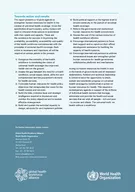/


It aims to Towards action and results 10point agenda Recognize the centrality of the health workforce in translating the vision of universal health coverage into improved health care on the ground Methods The report uses mixed methods in selecting c ID: 2830
Download Pdf The PPT/PDF document "A UNIVERSAL TRUTH NO HEALTH WITHOUT A WO..." is the property of its rightful owner. Permission is granted to download and print the materials on this web site for personal, non-commercial use only, and to display it on your personal computer provided you do not modify the materials and that you retain all copyright notices contained in the materials. By downloading content from our website, you accept the terms of this agreement.
A UNIVERSAL TRUTH: NO HEALTH WITHOUT EXECUTIVE SUMMARY + EXECUTIVE SUMMARY Purpose This report is intended to inform proceedings at the Third Global Forum on Human Resources for Health and to inform a global audience and trigger momentum for action. It aims to 1 Towards action Recognize the centrality of the health workforce in translating the vision of universal health coverage into improved The report uses mixed methods in selecting, collating and analysing country data. This includes analysing the workforce data in the WHO Global Health Observatory, searches of human resources scanning of “big picture” challenges in the To answer these questions, we use a conceptual protection oors: the availability, accessibility, Noting WHO’s statement that health services for delivering them, we adapted the availability, accessibility, acceptability and quality dimensions immediate future. Limitations include a reliance on published data and secondary sources. The available data also limit comparison between countries. Nevertheless, we can draw from the synthesis of information with reasonable con dence. 1 Assess the gap between the need for a health workforce, actual supply (stock, skills mix and competencies) and the population’s demand for Formulate human resources for health policy objectives that encapsulate the vision for the 3 ture is disability-friendly, referral mechanisms dignity, create trust and enable or promote Build the data, evidence base and strategic intelligence required to implement and monitor the policy objectives and to sustain 4 availability, accessibility, acceptability and quality Availabilityinformation base on available health workers. The WHO Global Health Observatory reports workforce data for 186 countries, but 53% of these countries have fewer than 7 annual data points on midwives, nurses and physicians across the past 20 years. Further, of the 57 countries identi ed in 2006 with low human resources for health density and low service coverage, 17 countries have no data point in the We created a global snapshot in comparison to three density thresholds of skilled health professionals (midwives, nurses and physicians) per 10 000 population. The three thresholds (22.8, 34.5 and 59.4 skilled health professionals per 10 000 population) were purposively selected to highlight the variation in health workforce availability. The report makes clear that the thresholds (often referred to incorrectly as benchmarks) are not developed to promote targets that a country should or must achieve 2 at the highest level to ensure continuity in the pursuit of countries, however, the net gains in stock are not commensurate with population growth. The We reviewed the available data on projected Reform the governance and institutional human resources for health Build and sustain the technical capacity to design, advocate for and but are used to illustrate the pattern of availability • 83• 100• 118• 68 Global Health Workforce Alliance: “all people, worker”. Variations in spatial accessibility to the health workforce more equitably. These 3 Technological advances in geographical the cost of the various scenarios of health Encourage international partners to focus their support and to report on their of cial development assistance for building the capacity of Encourage international partners to address transnational issues and strengthen global human resources for health governance, collaborative platforms and 9 8 10 nurses to physicians as proxies for acceptability, the health workforce. We found the following:• A 4 Acting on human resources for health is now in the hands of governments and all interested stakeholders. Political and technical leadership is critical to seize the opportunity to attain, sustain and accelerate progress on universal health coverage by transformative action on human resources for health. • 27• 35to regulate the access to the practice of medicine, dentistry and pharmacy. The situation is more varied for midwifery and nursing. However, the effectiveness of such mechanisms is not always clear.• Informulated or some error, misbehaviour or • There• The• Although• Availability• Adapting• Health• Performanceare afforded insuf cient priority.• Countryresources for health needs and design longer-• Humanimproving the essential availability, accessibility, systemic manner, linking health workforce 5 Towards a contemporary human resources for health agendaThe World Health Report 2000system’s inputs. Nevertheless, progress has not We analysed the workforce implications of the scope of future challenges. We estimated a • health• responsive• with• with• with• respectingworker,• providing 6 For further information, please contact:Global Health Workforce AllianceWorld Health OrganizationAvenue Appia 20Tel: +41 -22- 791 26 21Web: www.who.int/workforcealliance Towards action and resultsspeci cities of each country, policy-makers will with their needs and capacity. These are availability, accessibility, acceptability and quality competencies) and the population’s demand SUMMARY LTH WITHOUT